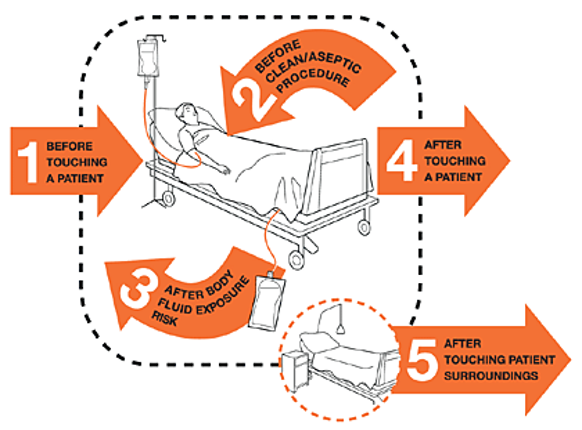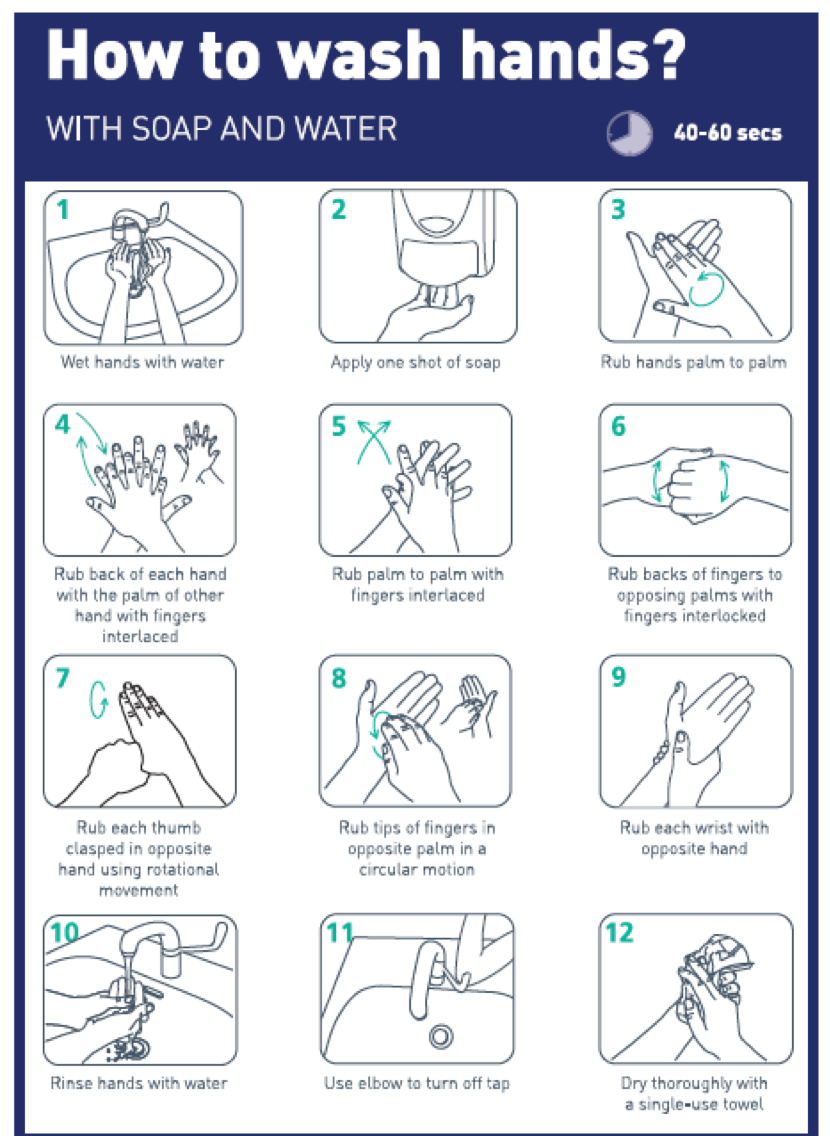WHEN
Around the patient
- Before touching a patient
- Before and after clean/aseptic procedure
- After body fluid exposure
- After touching a patient
- After touching patient surroundings
Five moments of care

Around the ward
- On arrival at and before leaving a ward or department
- After visiting the toilet
- Before serving/preparing food or drinks
- After any activity or contact that potentially results in hands becoming contaminated
- On entering and leaving an isolation cubicle
- After removal of gloves
CHOICE OF HAND HYGIENE PREPARATIONS
Alcohol hand rub
- Effective method of hand decontamination on visibly clean hands
- not recommended when hands are visibly dirty
- Do not use alcohol hand rub alone after caring for patients (or their equipment and environment) with suspected or known infectious diarrhoea
- such as Clostridium difficile or Norovirus
- regardless of whether gloves are worn
Soap and water
- Removes dirt, organic matter and transient flora by mechanical action
- Use hand washing with liquid soap and water
- when hands are visibly dirty or visibly soiled with body fluids or other organic matter
- when caring for patients with suspected or confirmed diarrhoea and/or vomiting
- patients with and during outbreaks of Clostridium difficile or Norovirus
- after several consecutive applications of alcohol hand rub
- after visiting the toilet
- Liquid soap alone does not provide sufficient hand disinfection before invasive procedures and surgery
Special situations
Aseptic non touch technique (ANTT)
- Before starting, wash hands with liquid soap followed by alcohol hand rub
- If required during procedure, use alcohol hand rub
Prolonged reduction in micro-organisms
- In surgery, some invasive procedures or in outbreak situations, use preparations containing antiseptic
- chlorhexidine, povidone iodine
TECHNIQUE FOR HAND HYGIENE
- Bare below elbow for all staff working within clinical areas
- no sleeves below elbow
- no wrist watches, wrist jewellery or plaster casts/wrist splints
- Do not wear false nails, nail extensions, gel nails or nail varnish
- Keep nails short and clean
- Before clinical work shift begins, remove stoned rings, wrist watches or other wrist jewellery
- Cover cuts and abrasions on hands and arms with waterproof dressings
Washing with soap and water
- Turn on taps using elbows if possible
- Wet hands under warm running water
- Apply soap or antiseptic detergent
- Lather well
- Rub vigorously for a minimum of 10–15 sec
- pay particular attention to tips of fingers, thumbs and between fingers
- Use technique that covers all surfaces of hands and wrists
- Rinse thoroughly
- Turn of taps using elbow where applicable
- some taps are sensor operated
- Dry hands with a disposable paper towel
- hand dryers are not recommended in clinical areas
- Dispose of paper towel in bin using foot operated mechanism
- prevent contamination of hands

Using alcohol-based hand gel
- Apply alcohol-based gel
- pay particular attention to tips of fingers, thumbs and between fingers
- Rub hands together until solution has evaporated and hands are dry
- ensure all areas of hands and wrists are covered and rub hands together

SKIN PROTECTION
- Apply an emollient hand cream regularly
- If any lesions or recurrent skin infections, or if any decontamination product causes skin irritation, contact occupational health team
© 2022 The Bedside Clinical Guidelines Partnership.
Created by University Hospital North Midlands and Keele University School of Computing and Mathematics.
Research and development team: James Mitchell, Ed de Quincey, Charles Pantin, Naveed Mustfa